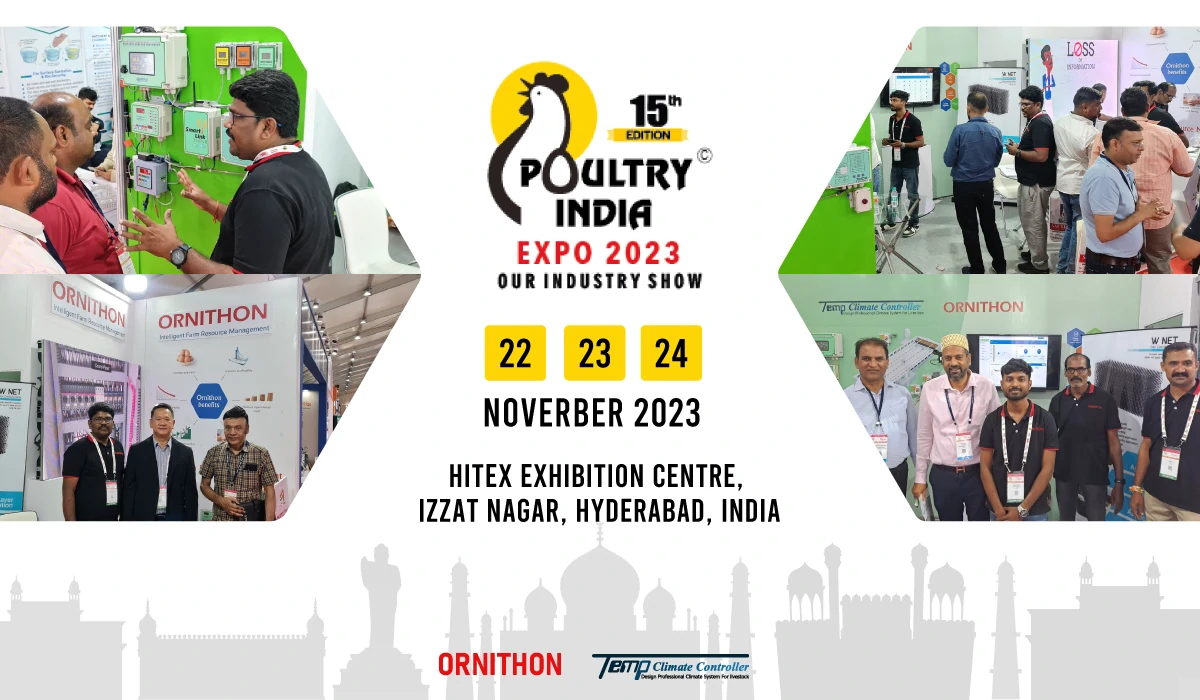Pig Building 2023
Thailand
1.2.1 Production
In 2018 – 2022, Thailand’s swine production decreased at a rate of 6.28% per year. In 2022, there was a production of 15.51 million pigs, down from 19.28 million pigs in 2021 by 19.55% due to damage to sow breeders. from the outbreak of ASF and small farmers slowing down farming to reduce the risk As a result, the overall amount of swine production decreased.
(1) Consumption demand
2018 – 2022 Thai pork consumption demand Decreased at a rate of 7.15 percent per year, which the pigs produced are mainly used for domestic consumption, about 99 percent of the total production volume. In 2022, there was a consumption of 1.15 million tons of swine, down from 1.31 million tons in 2021. 12.13 percent due to the rising price of pork Consumers therefore turn to consume other types of meat that are cheaper instead.

(2) Export
Year 2018 – 2022 Export Volume of Chilled and Frozen Pork Decrease at a rate of 15.60 percent per year. In 2022, Thailand exported chilled and frozen pork in the amount of 728 tons, worth 113.22 million baht, down from the volume of 14,180 tons, worth 1,721.70 million baht in 2021, 94.87 percent and 93.42 percent, respectively. The main export markets are Hong Kong, Myanmar, Lao PDR and Cambodia.
Year 2018 – 2022 Export Volume of Processed Pork Decrease at a rate of 12.37 percent per year. In 2022, Thailand exported 4,947 tons of processed pork, down from 5,532 tons in 2021 by 10.57 percent, while the export value was 1,218.73 million baht, an increase from 1,175.42 million baht. of the year 2021, 3.68 percent, with the main export markets being Japan, Cambodia, Hong Kong and Lao PDR.
(3) Import
Year 2018 – 2022 The amount of imported pork products Decrease at a rate of 6.79 percent per year. In 2022, Thailand imported 267 tons of pork products worth 85.71 million baht, a decrease from the volume of 334 tons worth 93.52 million baht in 2021, 20.00 percent and 8.35 percent, respectively, by bringing from countries in the European Union, Italy, Spain and Denmark.
In 2018 – 2022, imports of other edible parts of pigs (skin, liver and other offal) decreased at a rate of 2.21% per year. In 2022, Thailand imported other edible parts of pigs amounting to 27,814 tons worth 516.79 million baht, an increase from the quantity of 26,157 tons worth 506.38 million baht in 2021. Swine 6.34% and 2.06% respectively, imported from countries in the European Union, namely the Netherlands, Spain and Denmark.
(4) Price
1) The price that farmers can sell
Year 2018 – 2022, the price that farmers sell has increased at a rate of 13.31 percent per year, with the average price of pigs sold in 2022 at 99.20 baht per kg, 35.63 percent higher from 73.14 baht per kg in 2021

2) Export Price
In 2018 – 2022, the export price of chilled and frozen pork increased at a rate of 17.15 percent per year. In 2022, the average export price of chilled and frozen pork was 155.49 baht per kilogram, an increase from 121.42 baht per kilogram
3) Import Price
In 2018 – 2022, the import price of other edible parts of pigs and liver decreased at a rate of 4.86 percent per year and 0.54 percent per year, respectively. 16.50 baht per kilogram, a decrease from 18.22 baht per kilogram in 2021, 9.44 percent, while the average import price of liver is 22.27 baht per kilogram, an increase from 22.12 baht per kilogram in 2021, 0.67 percent.
Trend for 2023
2.1 of the world
2.1.1 Production
In 2023, the world’s pork production is expected to reach 110.98 million tons, an increase of 1.03 percent from 109.85 million tons in 2022 due to China, a major swine producing country. recovering from ASF damage and being able to increase production It is expected to have a production
volume of 52.00 million tons, an increase of 1.96 percent from 51.00 million tons in 2022, including the United States,
2.1.2 Marketing
(1) consumption demand
In 2023, the world’s pork consumption is expected to be 110.02 million tons, an increase of 1.24 percent from 108.68 million tons in 2022, because the world’s major pork consuming countries are China, the United States, and the European Union. There will be an increase in pork consumption from 2022 by 1.68 percent, 1.87 percent and 0.26 percent, respectively.
(2) Export
In 2023, the world’s pork exports are expected to total 10.50 million tons, a decrease of 1.59 percent from 10.67 million tons in 2022, because the world’s major pork exporting countries will have a decrease in export volume.
(3) Import
In 2023, it is expected that the world’s pork imports will total 9.55 million tons, down from 9.60 million tons in 2022 by 0.55% because the world’s major pork importing countries will have lower imports, especially China. The volume of pork imports is 1.70 million tons, down from 1.80 million tons in 2022, 5.56 percent, followed by Japan with an import volume of 1.50 million tons,
2.2 of Thailand
2.2.1 Production
In 2023, the production of pigs is expected to be 17.47 million heads, an increase of 12.66 percent from 15.51 million heads in 2022, due to the increasing number of sows sows will be able to expand their pig production. However, farmers are still concerned about the risk of disease outbreaks in swine. and increased production costs from biosecurity systems. Biosecurity affects farmers’ decision to return to raising pigs.

2.2.2 Marketing
(1) Consumption demand
In 2023, swine consumption is expected to be 1.30 million tons, an increase of 12.58 percent from 1.15 million tons in 2022 due to economic recovery. especially in the tourism and service sectors This will result in an increase in demand for pork consumption from the previous year.
(2) Export
In 2023, it is expected that the export of chilled, frozen and processed pork will increase slightly or close to 2022 due to economic recovery, especially in the food industry of trading partner countries, while exports of live pigs are expected to stabilize. This is because neighboring countries have limited demand for live pig imports due to the recovery in production after the outbreak of ASF.
(3) Import
In 2023, imports of pork products and other edible parts of pigs (skin, liver and other offal) are expected to be similar to 2022.
(4) price
In 2023, it is expected that the price of swine that farmers can sell will be stable or slightly lower compared to 2022 due to the expected increase in swine production. in line with increasing consumer demand Export prices of slaughtered pork and processed pork are expected to be close to 2022.
2.3 Factors affecting production or export
2.3.1 Disease outbreaks in swine Although at present pig farm management is more efficient and able to control epidemics better. However, there are still risk factors for swine epidemics such as Porcine Epidemic Diarrhea (PED), Porcine Reproductive and Respiratory Syndrome (PRRS), and African Cholera. African Swine Fever (ASF),
2.3.2 Increased production costs especially the cost of feed, energy and biosecurity. While pork is a product that has price control measures. Therefore, it may affect the decision of farmers to return to raising pigs.
2.3.3 The economic recovery after the COVID-19 epidemic has resulted in an increase in domestic and international demand for swine. This is a positive factor that will motivate farmers to increase the amount of swine production in line with market demand.
Pig building 2023
Thailand
1.2.1 Production
In 2018 – 2022, Thailand’s swine production decreased at a rate of 6.28% per year. In 2022, there was a production of 15.51 million pigs, down from 19.28 million pigs in 2021 by 19.55% due to damage to sow breeders. from the outbreak of ASF and small farmers slowing down farming to reduce the risk As a result, the overall amount of swine production decreased.
(1) consumption demand
2018 – 2022 Thai pork consumption demand Decreased at a rate of 7.15 percent per year, which the pigs produced are mainly used for domestic consumption, about 99 percent of the total production volume. In 2022, there was a consumption of 1.15 million tons of swine, down from 1.31 million tons in 2021. 12.13 percent due to the rising price of pork Consumers therefore turn to consume other types of meat that
are cheaper instead.
(2) Export
Year 2018 – 2022 Export Volume of Chilled and Frozen Pork Decrease at a rate of 15.60 percent per year. In 2022, Thailand exported chilled and frozen pork in the amount of 728 tons, worth 113.22 million baht, down from the volume of 14,180 tons, worth 1,721.70 million baht in 2021, 94.87 percent and 93.42 percent, respectively. The main export markets are Hong Kong, Myanmar, Lao PDR and Cambodia.
Year 2018 – 2022 Export Volume of Processed Pork Decrease at a rate of 12.37 percent per year. In 2022, Thailand exported 4,947 tons of processed pork, down from 5,532 tons in 2021 by 10.57 percent, while the export value was 1,218.73 million baht, an increase from 1,175.42 million baht. of the year 2021, 3.68 percent, with the main export markets being Japan, Cambodia, Hong Kong and Lao PDR.
Year 2018 – 2022, export quantity of breeding pigs and live pigs decreasing at a rate of 65.72 percent per year. In 2022, Thailand exported 2,959 breeding pigs and live pigs worth 39.60 million baht, a decrease from the amount of 1,277,351 animals worth 8,537.45 million baht in 2021, a decrease of 99.77 percent and 99.54 percent according to No. The main export markets are Myanmar and Lao PDR.
However, the overall export volume decreased as a result of pig production damaged by ASF disease, which is undergoing rehabilitation and development of pig farming under biosecurity systems.
(3) Import
Year 2018 – 2022 The amount of imported pork products Decrease at a rate of 6.79 percent per year. In 2022, Thailand imported 267 tons of pork products worth 85.71 million baht, a decrease from the volume of 334 tons worth 93.52 million baht in 2021, 20.00 percent and 8.35 percent, respectively, by bringing from countries in the European Union, Italy, Spain and Denmark.
In 2018 – 2022, imports of other edible parts of pigs (skin, liver and other offal) decreased at a rate of 2.21% per year. In 2022, Thailand imported other edible parts of pigs amounting to 27,814 tons worth 516.79 million baht, an increase from the quantity of 26,157 tons worth 506.38 million baht in 2021. Swine 6.34% and 2.06% respectively, imported from countries in the European Union, namely the Netherlands, Spain and Denmark.
(4) price
1) The price that farmers can sell
Year 2018 – 2022, the price that farmers sell has increased at a rate of 13.31 percent per year, with the average price of pigs sold in 2022 at 99.20 baht per kg, 35.63 percent higher from 73.14 baht per kg in 2021 due to the number of female breeders. decreased due to the problem of epidemics in swine In addition, the cost of production is higher due to the condition of animal feed raw materials that has increased considerably. While the demand for consumption remained stable.
2) Export price
In 2018 – 2022, the export price of chilled and frozen pork increased at a rate of 17.15 percent per year. In 2022, the average export price of chilled and frozen pork was 155.49 baht per kilogram, an increase from 121.42 baht per kilogram in 2021. 28.07
In 2018-2022, the price of processed pork decreased at a rate of 1.46 percent per year. In 2022, the average export price of processed pork was 246.33 baht per kilogram, an increase of 15.94 percent from 212.48 baht per kilogram in 2021.
3) Import price
In 2018 – 2022, the import price of other edible parts of pigs and liver decreased at a rate of 4.86 percent per year and 0.54 percent per year, respectively. 16.50 baht per kilogram, a decrease from 18.22 baht per kilogram in 2021, 9.44 percent, while the average import price of liver is 22.27 baht per kilogram, an increase from 22.12 baht per kilogram in 2021, 0.67 percent.
Trend for 2023
2.1 of the world
2.1.1 Production
In 2023, the world’s pork production is expected to reach 110.98 million tons, an increase of 1.03 percent from 109.85 million tons in 2022 due to China, a major swine producing country. recovering from ASF damage and being able to increase production It is expected to have a production volume of 52.00 million tons, an increase of 1.96 percent from 51.00 million tons in 2022, including the United States, Brazil and Mexico expanding production according to domestic demand and increased exports from economic recovery. economy The production volume is expected to increase from 2022 by 0.72 percent, 1.61 percent and 4.58 percent, respectively. Important agricultural situation and trends in 2023
2.1.2 Marketing
(1) consumption demand
In 2023, the world’s pork consumption is expected to be 110.02 million tons, an increase of 1.24 percent from 108.68 million tons in 2022, because the world’s major pork consuming countries are China, the United States, and the European Union. There will be an increase in pork consumption from 2022 by 1.68 percent, 1.87 percent and 0.26 percent, respectively.
(2) Export
In 2023, the world’s pork exports are expected to total 10.50 million tons, a decrease of 1.59 percent from 10.67 million tons in 2022, because the world’s major pork exporting countries will have a decrease in export volume. especially the European Union It is expected that there will be 3.76 million tons of pork exports, down from 3.90 million tons in 2022 by 3.59 percent, followed by the United States with an export volume of 2.85 million tons, down from 2.90 million tons in 2022 by 1.69 percent and Canada exported 1.40 million tons, down from 1.43 million tons in 2022, 1.75 percent.
(3) Import
In 2023, it is expected that the world’s pork imports will total 9.55 million tons, down from 9.60 million tons in 2022 by 0.55% because the world’s major pork importing countries will have lower imports, especially China. The volume of pork imports is 1.70 million tons, down from 1.80 million tons in 2022, 5.56 percent, followed by Japan with an import volume of 1.50 million tons, down from 1.53 million tons in 2022, 1.64 percent, and Mexico will have a volume of 1.50 million tons. Imports were 1.24 million tonnes, down 0.80 percent from 1.25 million tonnes in 2022. In addition, the Philippines is expected to import pork down 18.18 percent compared to 2022 due to the temporary expiration of pork import tax cuts to resolve the problem. Swine shortage due to AFS outbreak
2.2 of Thailand
2.2.1 Production
In 2023, the production of pigs is expected to be 17.47 million heads, an increase of 12.66 percent from 15.51 million heads in 2022, due to the increasing number of sows sows will be able to expand their pig production. However, farmers are still concerned about the risk of disease outbreaks in swine. and increased production costs from biosecurity systems. Biosecurity affects farmers’ decision to return to raising pigs.
2.2.2 Marketing
(1) Consumption demand
In 2023, swine consumption is expected to be 1.30 million tons, an increase of 12.58 percent from 1.15 million tons in 2022 due to economic recovery. especially in the tourism and service sectors This will result in an increase in demand for pork consumption from the previous year
.
(2) Export
In 2023, it is expected that the export of chilled, frozen and processed pork will increase slightly or close to 2022 due to economic recovery, especially in the food industry of trading partner countries, while exports of live pigs are expected to stabilize. This is because neighboring countries have limited demand for live pig imports due to the recovery in production after the outbreak of ASF.
(3) Import
In 2023, imports of pork products and other edible parts of pigs (skin, liver and other offal) are expected to be similar to 2022.
(4) price
In 2023, it is expected that the price of swine that farmers can sell will be stable or slightly lower compared to 2022 due to the expected increase in swine production. in line with increasing consumer demand Export prices of slaughtered pork and processed pork are expected to be close to 2022.
2.3 Factors affecting production or export
2.3.1 Disease outbreaks in swine Although at present pig farm management is more efficient and able to control epidemics better. However, there are still risk factors for swine epidemics such as Porcine Epidemic Diarrhea (PED), Porcine Reproductive and Respiratory Syndrome (PRRS), and African Cholera. African Swine Fever (ASF), etc. Improving farm biosecurity for disease surveillance and disease prevention has resulted in higher production costs for farmers. In addition, Thailand has not been certified to be free of FMD disease, thus limiting the export of slaughtered pork and processed pork abroad.
2.3.2 Increased production costs especially the cost of feed, energy and biosecurity. While pork is a product that has price control measures. Therefore, it may affect the decision of farmers to return to raising pigs.
2.3.3 The economic recovery after the COVID-19 epidemic has resulted in an increase in domestic and international demand for swine. This is a positive factor that will motivate farmers to increase the amount of swine production in line with market demand.
ขอบคุณ สมาคมผู้เลี้ยงสุกร
Pig building 2023
Thailand
1.2.1 Production
In 2018 – 2022, Thailand’s swine production decreased at a rate of 6.28% per year. In 2022, there was a production of 15.51 million pigs, down from 19.28 million pigs in 2021 by 19.55% due to damage to sow breeders. from the outbreak of ASF and small farmers slowing down farming to reduce the risk As a result, the overall amount of swine production decreased.
(1) consumption demand
2018 – 2022 Thai pork consumption demand Decreased at a rate of 7.15 percent per year, which the pigs produced are mainly used for domestic consumption, about 99 percent of the total production volume. In 2022, there was a consumption of 1.15 million tons of swine, down from 1.31 million tons in 2021. 12.13 percent due to the rising price of pork Consumers therefore turn to consume other types of meat that are cheaper instead.

(2) Export
Year 2018 – 2022 Export Volume of Chilled and Frozen Pork Decrease at a rate of 15.60 percent per year. In 2022, Thailand exported chilled and frozen pork in the amount of 728 tons, worth 113.22 million baht, down from the volume of 14,180 tons, worth 1,721.70 million baht in 2021, 94.87 percent and 93.42 percent, respectively. The main export markets are Hong Kong, Myanmar, Lao PDR and Cambodia.
Year 2018 – 2022 Export Volume of Processed Pork Decrease at a rate of 12.37 percent per year. In 2022, Thailand exported 4,947 tons of processed pork, down from 5,532 tons in 2021 by 10.57 percent, while the export value was 1,218.73 million baht, an increase from 1,175.42 million baht. of the year 2021, 3.68 percent, with the main export markets being Japan, Cambodia, Hong Kong and Lao PDR.
Year 2018 – 2022, export quantity of breeding pigs and live pigs decreasing at a rate of 65.72 percent per year. In 2022, Thailand exported 2,959 breeding pigs and live pigs worth 39.60 million baht, a decrease from the amount of 1,277,351 animals worth 8,537.45 million baht in 2021, a decrease of 99.77 percent and 99.54 percent according to No. The main export markets are Myanmar and Lao PDR.
However, the overall export volume decreased as a result of pig production damaged by ASF disease, which is undergoing rehabilitation and development of pig farming under biosecurity systems.
(3) Import
Year 2018 – 2022 The amount of imported pork products Decrease at a rate of 6.79 percent per year. In 2022, Thailand imported 267 tons of pork products worth 85.71 million baht, a decrease from the volume of 334 tons worth 93.52 million baht in 2021, 20.00 percent and 8.35 percent, respectively, by bringing from countries in the European Union, Italy, Spain and Denmark.
In 2018 – 2022, imports of other edible parts of pigs (skin, liver and other offal) decreased at a rate of 2.21% per year. In 2022, Thailand imported other edible parts of pigs amounting to 27,814 tons worth 516.79 million baht, an increase from the quantity of 26,157 tons worth 506.38 million baht in 2021. Swine 6.34% and 2.06% respectively, imported from countries in the European Union, namely the Netherlands, Spain and Denmark.
(4) price
1) The price that farmers can sell
Year 2018 – 2022, the price that farmers sell has increased at a rate of 13.31 percent per year, with the average price of pigs sold in 2022 at 99.20 baht per kg, 35.63 percent higher from 73.14 baht per kg in 2021 due to the number of female breeders. decreased due to the problem of epidemics in swine In addition, the cost of production is higher due to the condition of animal feed raw materials that has increased considerably. While the demand for consumption remained stable.
2) Export price
In 2018 – 2022, the export price of chilled and frozen pork increased at a rate of 17.15 percent per year. In 2022, the average export price of chilled and frozen pork was 155.49 baht per kilogram, an increase from 121.42 baht per kilogram in 2021. 28.07
In 2018-2022, the price of processed pork decreased at a rate of 1.46 percent per year. In 2022, the average export price of processed pork was 246.33 baht per kilogram, an increase of 15.94 percent from 212.48 baht per kilogram in 2021.
3) Import price
In 2018 – 2022, the import price of other edible parts of pigs and liver decreased at a rate of 4.86 percent per year and 0.54 percent per year, respectively. 16.50 baht per kilogram, a decrease from 18.22 baht per kilogram in 2021, 9.44 percent, while the average import price of liver is 22.27 baht per kilogram, an increase from 22.12 baht per kilogram in 2021, 0.67 percent.
Trend for 2023
2.1 of the world
2.1.1 Production
In 2023, the world’s pork production is expected to reach 110.98 million tons, an increase of 1.03 percent from 109.85 million tons in 2022 due to China, a major swine producing country. recovering from ASF damage and being able to increase production It is expected to have a production volume of 52.00 million tons, an increase of 1.96 percent from 51.00 million tons in 2022, including the United States, Brazil and Mexico expanding production according to domestic demand and increased exports from economic recovery. economy The production volume is expected to increase from 2022 by 0.72 percent, 1.61 percent and 4.58 percent, respectively. Important agricultural situation and trends in 2023
2.1.2 Marketing
(1) consumption demand
In 2023, the world’s pork consumption is expected to be 110.02 million tons, an increase of 1.24 percent from 108.68 million tons in 2022, because the world’s major pork consuming countries are China, the United States, and the European Union. There will be an increase in pork consumption from 2022 by 1.68 percent, 1.87 percent and 0.26 percent, respectively.
(2) Export
In 2023, the world’s pork exports are expected to total 10.50 million tons, a decrease of 1.59 percent from 10.67 million tons in 2022, because the world’s major pork exporting countries will have a decrease in export volume. especially the European Union It is expected that there will be 3.76 million tons of pork exports, down from 3.90 million tons in 2022 by 3.59 percent, followed by the United States with an export volume of 2.85 million tons, down from 2.90 million tons in 2022 by 1.69 percent and Canada exported 1.40 million tons, down from 1.43 million tons in 2022, 1.75 percent.
(3) Import
In 2023, it is expected that the world’s pork imports will total 9.55 million tons, down from 9.60 million tons in 2022 by 0.55% because the world’s major pork importing countries will have lower imports, especially China. The volume of pork imports is 1.70 million tons, down from 1.80 million tons in 2022, 5.56 percent, followed by Japan with an import volume of 1.50 million tons, down from 1.53 million tons in 2022, 1.64 percent, and Mexico will have a volume of 1.50 million tons. Imports were 1.24 million tonnes, down 0.80 percent from 1.25 million tonnes in 2022. In addition, the Philippines is expected to import pork down 18.18 percent compared to 2022 due to the temporary expiration of pork import tax cuts to resolve the problem. Swine shortage due to AFS outbreak
2.2 of Thailand
2.2.1 Production
In 2023, the production of pigs is expected to be 17.47 million heads, an increase of 12.66 percent from 15.51 million heads in 2022, due to the increasing number of sows sows will be able to expand their pig production. However, farmers are still concerned about the risk of disease outbreaks in swine. and increased production costs from biosecurity systems. Biosecurity affects farmers’ decision to return to raising pigs.














Pingback:INTERNATIONAL POULTRY SHOW -